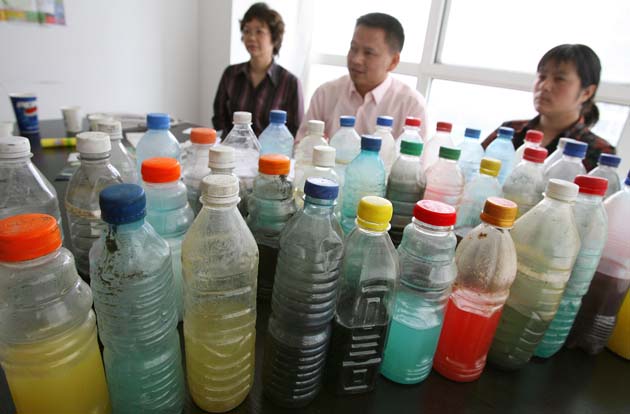Environmental Bad Dream
Wasting AwayThe more unpredictable the world is the more we rely on predictions. - Steve Rivkin |
| 15% of deaths in China are due to poor air quality. | |
| 4 - 5% of deaths are through diseases caused by water pollution. | |
| Most of the surface and ground water in cities and in the countryside is polluted. | |
| Only 5% of household waste and 17% of industrial waste receives any treatment before entering the environment. | |
| About 20% of agricultural land has been lost to soil erosion and economic development over the last decade. |
Air and water pollution alone cost the Chinese economy more than 8% - US$74 billion - of its Gross Domestic Product, said Dr Anwar. Before 2004 about US$100 billion would be needed for infrastructure investment in water conservation, treatment and sanitation, he added.
While the government was conscious of the problems and was trying to do something, it lacked money and skills, faced corruption problems, competition among environmental agencies plus rapidly changing legislation and increasingly detailed regulations that tended to gridlock progress.
"This is an area where China needs help," Dr Anwar said.
Source: Asia 2000 Foundation of New Zealand Review July/August 2000
![]()
A Great Wall of Waste
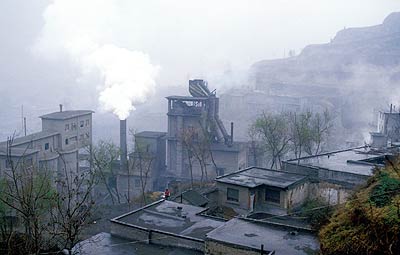
[Excerpt]
In late July an environmental disaster occurred on the Huai river, one of China's seven big rivers. A 133km-long black and brown plume swept along the river killing millions of fish and devastating wildlife. According to Mr Pan, the catastrophe occurred because too much water had been taken from the river system, reducing its ability to clean itself. Others say that numerous factories dump untreated waste directly into the water.
As for used water, with a national daily sewage rate of around 3.7 billion tonnes, China would need 10,000 waste-water treatment plants costing some $48 billion just to achieve a 50% treatment rate, according to Frost & Sullivan, a consultancy. Vhima's State Environmental Protection Administration (SEPA) found over 70% of the water in five of China's seven major river systems was unsuitable for human contact. As more people move into cities, the problem of household waste is becoming severe. Only 20% of China's 168m tonnes of solid waste per year is properly disposed of.
The air is not much better. “If I work in your Beijing, I would shorten my life at least five years,” Zhu Rongji told city officials when he was prime minister in 1999. According to the World Bank, China has 16 of the world's 20 most polluted cities. Estimates suggest that 300,000 people a year die prematurely from respiratory \ diseases.
***
The main reason is that around 70% of China's mushrooming energy needs are supplied by coal-fired power stations, compared with 50% in America. Combined with the still widespread use of coal burners to heat homes, China has the world's highest emissions of sulphur dioxide and a quarter of the country endures acid rain. In 2002, SEPA found that the air quality in almost two-thirds of 300 cities it tested failed World Health Organisation standards — yet emissions from rocketing car ownership are only just becoming an issue. Hopes that China will “leapfrog” the West with super-green cars are naive, since dirty fuel messes up clean engines and the high cost of new cars keeps old ones on the road. Sun Jian, the second-ranking official at Shanghai's environmental protection bureau, estimates that 70% of Shanghai's one million cars do not even reach the oldest European emission standards.
Farmland erosion and desertification resulted in Beijing being hit with 11 sandstorms in 2000, prompting Mr Zhu to wonder whether the advancing desert might force him to relocate the capital. A year later, the yellow dust clouds were so extensive that they raised complaints in South Korea and Japan and travelled as far as America. A partial logging ban and massive replanting appear to have reversed China's deforestation, but its grass and agricultural land continue to shrink.
dding it all up, the World Bank concludes that pollution is costing China an annual 8 - 12% of its $1.4 trillion GDP in direct damage, such as the impact on crops of acid rain, medical bills, lost work from illness, money spent on disaster relief following floods and the implied costs of resource depletion. With health costs escalating, that figure will increase, giving rise to some grim prognoses that growth itself will be undermined. “Ignored for decades, even centuries, China's environmental problems have the potential to bring the country to its knees economically,” argues Elizabeth Economy, author of The River Runs Black, a new book on China's pollution.
SEPA's Mr Pan is gloomier still: “Our natural resources will soon be unable to support our population.” His predecessor Qu Geping, the first head of China's National Environmental Protection Agency (SEPA's forerunner) in 1985, believes that while the official goal of quadrupling 2002 GDP by 2020 can be “healthily achieved”, if nothing is done about the environment, economic growth could grind to a halt.
But China's relationship with its environment has long been uneasy. For centuries, the country's rulers subjugated their surroundings rather than attempting to live in harmony with them. Mao declared that man must “conquer nature and thus attain freedom from nature”. In the past two decades, the toll extracted by China's manufacturing-led development and the sheer scale of its 9%-a-year economic expansion has only increased.
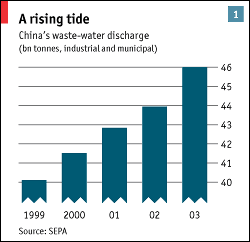
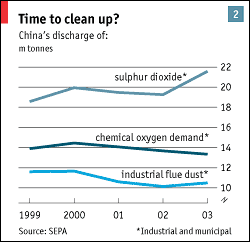
Source: economist.com 19 August 2004 © The Economist all rights reserved. photo credit Ropi
![]()
A Coal-Dependent Future?
 by Susan Watts
by Susan Watts
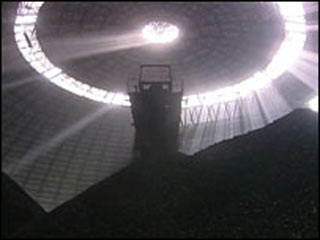 Coal built China - and fuels its relentless growth today - 80% of China's electricity
comes from coal, and there are plans for 544 new coal-fired power stations - to meet an insatiable demand for energy. Yet coal is a prime source of carbon
dioxide - the global warming gas. If the power plants go ahead, it will be all but impossible to avoid dangerous climate change.
Coal built China - and fuels its relentless growth today - 80% of China's electricity
comes from coal, and there are plans for 544 new coal-fired power stations - to meet an insatiable demand for energy. Yet coal is a prime source of carbon
dioxide - the global warming gas. If the power plants go ahead, it will be all but impossible to avoid dangerous climate change.
Traffic jams were unheard of in Beijing just a few years ago. Now, one in four families in China owns a car. Since China let in market forces, its politicians know they must keep delivering economic prosperity to stay in power. The whole city hopes to get rich when the Olympics come to Beijing in three years time. China wants to be seen as a vibrant, go-ahead nation. It's tearing down the Hutong courtyard homes of Beijing's poorest - eager to banish their Dickensian alleyways. In their place come modern flats and all the energy-guzzling domestic appliances that come with them.

Traffic jams in Beijing were unheard of a few years ago
Over the past two decades, China has put economic growth above all else, and with 200 million Chinese still living on less than a dollar a day, relieving poverty remains vital. Coal offers the way out. The 80% of the country's electricity which comes from coal is twice the average, worldwide. And for the time being, as the demand for power grows, this means one thing - more emissions of climate-changing gases.
For the Chinese government's advisors the choices are clear. "My understanding of the Chinese government's point of view and ordinary people's point of view is that you have to prioritise," Pan Juihua, executive director at the Chinese Academy of Social Sciences, told us. "When you have many choices you have to consider the constraints, when you have many problems you have to prioritise. When you have poverty you have to tackle poverty first."
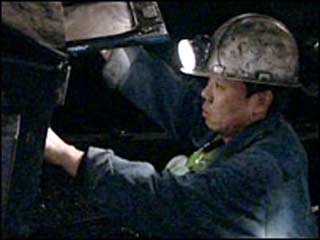
6,000 were killed in China's coal mines just last year
Supplying that energy comes at a cost. On the day we arrived in China, 214 miners lost their lives in a gas explosion. The safety figures suggest corners are being cut to maximise supply. Officially, 6,000 were killed in China's coal mines just last year - that's 20 a day. Methane explosions are the main culprit. But it's not just a safety hazard - methane's also a greenhouse gas... 20 times as damaging as carbon dioxide. Most of the accidents happen in China's small, private mines where high production figures count for more than people's lives. The skeletal structures over the mine shafts mark each site of underground toil, dotted across the landscape as we drove through China's coal-rich Shanxi province. Jumpy local officials prevented us from filming here... such was their anxiety over what we might see. At our destination - a state-run coal mine in northern China - they say they've had no deaths since they started up three years ago. The mine supports a massive community of 3,000 miners, and their families.
The Sihe mine is being held up as a role model. It's one of China's largest and most modern coal mines, expected to produce 10 million tonnes of coal before the year's out. It's the first mine in China to tackle greenhouse gas emissions by capturing the methane released from the earth as the coal is mined. Before, the methane was sent straight into the atmosphere. Now, it's diverted into a small gas-fired power station. The scheme generates paper credits that the mine group has sold to the World Bank, for $20 million. As well as the extra money, the scheme should make the mine safer - with less methane around. It's a small first step to making coal less damaging to the environment.
The head of the mining group, Wen Shihua, wants others to take a bigger share of the task of cleaning up the planet. "We are a country with a lot of coal, very little oil and very little gas. The development of coal is the basis of the development of the country. There is no way that we can replace our production of coal or use alternative sources of energy to totally replace it. Because the US and some Western governments don't abide by the Kyoto Protocol, they are not willing to reduce their carbon emissions... we feel very annoyed about that."
But the scale of China's own entangled history with coal is overwhelming. Right across northern China, coal seams burn in un-stoppable fires. Some have been burning naturally for thousands of years, but others are being set alight by small-scale mining operations seeking to cash-in on soaring coal prices. Together, these perpetual fires are letting off a total amount of carbon dioxide each year equal to all the cars in the USA. It's in China's interests to limit its climate-changing emissions from coal because the effects are already being felt. Central Asia is drying out, partly as a result of global warming - and it's going to get worse. Deserts make up a quarter of China's land - mostly in the north, and they're growing. After decades of over-grazing and poor use of land - infertile soil and erosion are the result - and the blinding red sandstorms that plague Beijing. Climate scientists say China's northern deserts are growing at an alarming rate - by several thousands of kilometres squared every year. Yang Weixi, chief engineer at China's National Bureau to Combat Desertification, explained. "Desertification causes a reduction in our natural resources and it destroys our quality of life. People's living space is ever decreasing. It affects farming, crop production and transport. It affects people's lives."
The effects of climate change could prove devastating for China's cities too. Shanghai, like the rest of China's eastern coastal cities, is built on a river delta. It's desperately vulnerable to flood. The bigger the city gets, the more energy it consumes, feeding its own destruction by making sea-level rise due to global warming all the more likely. "We're assuming that in the next 50 years the sea level here might be 50cm higher than the present sea level," Professor Chen Zhongyuan of East China Normal University, told us. "That is a huge concern for the people living here. We have 16 to 17 million people living here so we need fresh water. If fresh water is affected by a salt water invasion, then the whole city is collapsing... Shanghai is getting more and more important for international trade, so we want to protect it..."
In fact, the latest estimates suggest the impact of sea-level rise on Shanghai itself could be far worse. The sea-level rises officials are expecting could hit in just 20 years, not 50.
Fundamental change is what's needed. China's coal-based economy is entrenched, and there are plans for another 500 coal-burning power stations. What China does now will decide how much damage it causes the world's atmosphere. If it builds these coal-fired power stations it will push carbon dioxide concentrations right up to the 400 parts per million level at which scientists expect dangerous climate change.
Zhou Dadi of Beijing's Energy Research Institute, told us: "We need a new model of development that means high level living standards with lower emissions per capita. If we can find such a model China will follow that." He wants Western governments to offer technology partnerships that are not just about making a fast buck in the new China. His country needs technical solutions that allow it to burn coal without destroying the planet.
Susan Watts is the science editor for Newsnight
Source: news.bbc.co.uk 9 March 2005 © BBC MMV
![]()
Huanghe, the Yellow River
by Richard Cowen
"Whoever controls the Yellow River controls China," said the Great Yu, who is credited with the first "taming" of the river around 2200 BC. Well he might: according to legend, his reward was to be made Emperor.
The Yellow River flows across a great blanket of loess, deposited by winds that blew out of the Siberian tundra during the Ice Age. The river erodes the loess easily, carrying along 60 times the sediment load of the Mississippi, until it reaches the plains of North China, still 1,400 river km from the sea. The river carries more sediment than any other major river in the world when it reaches the North China Plain. Then the sediment is deposited as fine silt, building up the river bed until it is high above the surrounding plains. In flood times the river may burst its banks, turning the plain into a flood plain, and unable to return to its breached course as the flood recedes. The Yellow River now finds a new way to the sea, and the cycle begins again.
The changes of course have been spectacular, and the river mouth has sometimes changed catastrophically by hundreds of kilometers. It has had 26 major changes in course in the past 2,000 years. The river is so treacherous that there was no permanent bridge across it until 1905...
![]()
To read the remainder of this spectacular and important essay about the Yellow River, please click here: www.geology.ucdavis.edu
![]()
Yellow River "Drying Up"

Millions of farmers might be forced to migrate...
by Rupert Wingfield-Hayes
The Yellow River valley in northern China is known as the cradle of Chinese civilisation. It's what the Nile is to ancient Egypt, the Tigris and Euphrates to the Babylonians. This is where the Chinese first learned to till and irrigate the land and where porcelain was first made 1,000 years before its "invention" in Europe. It's not really a valley at all, more a vast expanse of plains and mountains stretching for 2,000km from the river's source high on the edge of the Tibetan plateau, to its mouth on the Yellow Sea.
Along the river's banks live a third of China's enormous population, more than 400 million people. The vast plains that are irrigated by its muddy waters produce most of China's wheat, much of its maize and even some of its rice. The Yellow River is also known as "China's sorrow". The name comes from its propensity to run wild, regularly inundating large swathes of the North China plain, and drowning tens of thousands of its inhabitants. But today the Yellow River is more famous for the exact opposite. For more than 200 days of the year this once mighty river no longer makes it to the sea. It's like the Rhine petering out in central Germany, or the Nile drying up in northern Sudan.
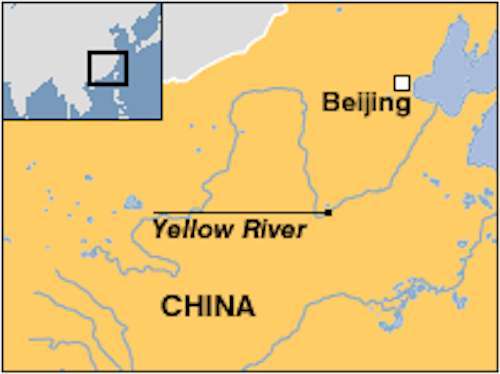
Why? In large part humans are to blame, in particular China's communist rulers, who have long believed nature should be bent to man's will. The river has been overused and abused. Dozens of dams block its flow, drawing off huge quantities of water to grow cotton in the desert. In 50 years the communists have done more to destroy the river than their predecessors in the last 5,000. Today the whole region teeters on the edge of disaster. Global warming could push it over the edge. In the next 50 years temperatures in Northern China are expected to rise by 3 to 4ºC. As they do, the already arid climate will dry further. The drought that has afflicted the region for the last six years would become permanent. The whole Yellow River valley will dry up.
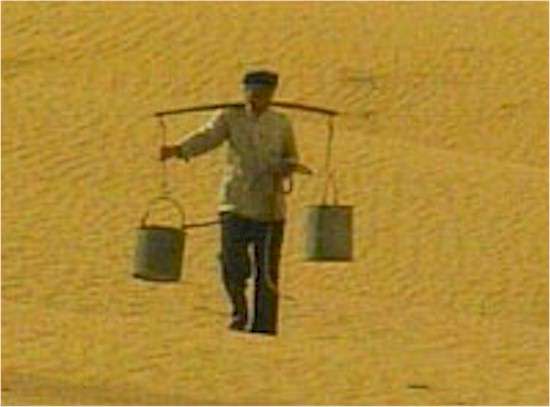
Economic policy has contributed to the river's decline
The impact on crops would be dramatic. Scientists predict yields in China's main wheat growing region could fall by 20% to 40%. This would force China to import huge quantities of wheat, maize and even rice. But worse will be the effect upon those who live along the river. Some are now predicting the creation of a dustbowl that would dwarf that of the American mid-west during the 1930s. That forced hundreds of thousands of Americans farmers off the land in a mass migration to California. But in China the effect would be much worse. Literally tens of millions of farmers could be pushed off the land, and China has no California for them to move to. Instead they would flood in to the cities, further swelling the ranks of the unemployed and dispossessed.
For China's leaders, it's a frightening prospect.

Rupert Wingfield-Hayes is the BBC correspondent in Ningxia, on the edge of the Gobi desert
Source: news.bbc.co.uk Thursday 29 July 2004
![]()
Chinese Prime Minister Admits Sandstorms Are Sign of "Ecological Destruction"
by Clifford Coonan
Beijingers unfurled their face-scarves and wiped the coating of yellow dust off their homes yesterday after days of sandstorms which deposited on to the capital 300,000 tons of sand from the Gobi desert and dust from the thousands of building sites around the city. By the time the sandstorms whipped Beijing, they had picked up a large dose of heavy metals and carcinogens which, over the past week, caused a suffocating layer of foul air to hang over China's capital.
The head of China's environment watchdog warned yesterday that worsening water and air pollution could soon become a political issue and translate into social tension, riot and protests. "The environment has become a focal issue that triggers social contradictions," Zhou Shengxian, the head of the state environmental protection administration (Sepa), told The Beijing News. His views were echoed by Wen Jiabao, the Prime Minister. "The succession of dust storms is a warning to us. Ecological destruction and environmental pollution are creating massive economic losses and gravely threatening people's lives and health," he said earlir this week. The premier said China had no problem meeting economic goals but was faltering on environmental targets. China's sulphur dioxide emissions last year were 27% higher than in 2000, despite the goal set by the government to reduce emissions by 10% over that time.
The World Bank says 16 of the world's 20 most polluted cities are in China and so far this year the capital has recorded just 56 days with blue skies - 16 fewer than for the same time last year. Environmental damage has sparked widespread anger and many citizens have taken to the streets to protest. Peng Lei, of the conservation group World Wildlife Fund, said China was sacrificing the environment for the fast growth of the economy. "The model of economic development is not sustainable," Mr Peng said.
Source: news.independent.co.uk 21 April 2006
![]()
Sustainable Development and Air Pollution in China and India
by Ryan Teague
Overview
Air pollution is a global problem that must be dealt with now so future generations will be able to survive on this planet. Since air pollution is a global issue every nation is a culprit. However, some countries are heavier polluters than others are. Most of the nations that are heavy air polluters are located in the developing world. This is due to these nations' efforts to catch up to economic capability of the industrial nations. The result of these efforts are less strict, if any, regulation towards environmental protection. Two rapidly developing nations that are greatly contributing to air pollution are China and India. Even though both countries have high pollution levels, their governments are now acting to attempt to curb the current pollution trends. This is a positive step toward providing future generations with a better quality of life.
China
Since China has begun to industrialise it has increasingly become a heavy air pollution producer. The source of this pollution is due to many factors such as an increase in coal use and a rapidly growing automobile population. These problems have bean to effect crops and increase health problems in the population. Fortunately the Chinese government has began to take action to help weaken the problem.
Problems:
A majority of the air pollution problems lie in the urban areas of the country. The pollution levels in many of the cities have reached levels 10 times that of the standard proposed by the World Health Organization.
One of the major sources of Chinese air pollution is from sulfur-dioxide emissions. The major contributor to the sulfur-dioxide emissions is due to increased coal consumption in the industrial sector. Between 1989 and 1993 China's annual coal consumption increased by 2% a year. By the end of this century the Chinese are estimated to burn over 1.5 billion metric tons of coal. The major user of coal in China is the industrial sector, accounting for nearly 2/3 of coal use. One major factor effecting this is the continued use of inefficient industrial boilers.
Another problem contributing to the problem in China is the increasing number of automobiles on Chinese roads. In 10 years, from 1984 to 1994, the numbers of automobiles in China increased form less that 2.4 million to over 9.4 million. According to the Dow Jones the increase in cars is because household have the money to afford cars.(1) The reason that automobiles are creating this pollution is because of poor road infrastructure, old vehicle technology, and emission standard similar to those in the US in the early 1970s.
Effects:
One effect that the air pollution has had on the country is in the agriculture sector. The pollution from the urban areas began effecting the crop yields in the rural areas. In some rural areas, like the town of Linan, the ozone levels surpass 60 parts per billion. This high ozone level can have devastating effects on crops, possibly causing a reduction in crop yield by 10%. This has raised questions if China will be ale to feed its enormous population in the new millennium.
Health risks have also been a consequence of the increasing air pollution in China. The exposure to pollution has lead to increased rates of lung cancer, respiratory infections, heart diseases, and asthma in the Chinese public. Pollution has also aided in the increased rates of mortality and morbidity in China. This is supported by the fact the now 35.6 out of every 100,000 deaths in urban areas are a result of lung cancer, and respiratory diseases have increased by 25% since 1989.(2)
Solutions:
The Chinese government has already begun taken steps to try and reduce the amount of pollution. They are currently trying to reduce their dependency on coal for power generation. This is being done with help from multi-national organisations such as the World Bank. The World Bank is providing loans for tasks like the Xiaolangdi Multipurpose Project, which is to provide money to build hydroelectric dams. This would decrease the amount of coal need to generate power, thus decreasing toxic emissions. The government is also exploring renewable less polluting resources. They are gradually shifting to natural gas in domestic and industrial uses.(2)
China is also attempting to reduce emissions in the automotive population. They are doing this with aid from foreign manufactures. General Motors is aiding the Chinese government in developing proper vehicle emission standards.(1) The government is also pursuing the electric car market with assistance from Peugeot. They are hoping to produce 5,000 electric cars per year by the beginning of the century.
The government is also trying to reduce the concentration of pollution in urban areas. They are doing this by moving state-owned industries outside of the major cities dental areas.(2) This may not help the problem, however it will lower the pollution that exist in China's densely populated cities.
![]()
India
Problems:
The national capital, New Delhi, is one of the most polluted cities in the world and has very high levels of air pollution. This trend is not limited to New Delhi, but plagues a majority of India's urban areas.
One contributing factor to India's high level of air pollution is poor vehicle emission standards. Many vehicle industries are still producing vehicles that produce toxic emissions. One aiding factor to this is the continual use of substandard diesel engines. The diesel engines currently being used in India produce three major air pollutants: nitrogen oxide, sulfur dioxide, and suspended particle matter (SPM). Motorcycle manufactures in India are still using two-stroke engines instead of four-stroke engines in their products. The two-stroke engines produce more unburned hydrocarbons, resulting in more air pollution, than their four-stroke counter parts. Other factors that have contributed to the rise in pollution have been due to government actions. The government has encouraged the growth in the personal automobile population, by not raising vehicle taxes, stressing private transportation, and not promoting community transportation like commuter trains.
India also has a problem with aerosol use. The aerosol pollution has created a brownish haze over 10 million square kilometers over the Indian Ocean during the monsoon season. The pollution comes from the main land but is carried over the ocean when monsoon seasons arrive, making it extremely visible. The pollution is caused by the extensive use of aerosols. These are chemicals that are found in daily items such as spray cans.
Results:
The major result of India's air pollution problem is its effect on the public's health. Much of the SPM emitted by vehicles are very toxic and are also carcinogenic. The air pollution has lead to an increase in health problems like chronic asthma and respiratory diseases. These health problems have lead to increased medical bills, missed work time, and decreased production in India's large population.
Another result of the air pollution is it has other effects on the environment. The high levels of pollution have resulted in increased acid rain, which effects plant life ant the ground water supply. A direct effect of the haze over the Indian Ocean is that it reduces the heat in the area and effect the plant life growing in the ocean. This also has an impact on the entire marine-life food chain.
Solutions:
Similar to China, India's government has begun to take steps in reducing it severe air pollution problem. They have looked to international organisations, like the World Bank, for aid. The World Bank has provided India with a $50 million credit to aid in curbing the environmental problems.
Other solutions that have been explored in efforts to reduce India's air pollution are the use of alternative fuels in its vehicle industries. Some of the alternative fuels being explored are propane, ethanol, and methanol. These fuels have been proven world wide as acceptable means to replace petroleum based fuels, and they are far less polluting than their petroleum counterparts. Some manufactures are also pursuing the development of electric cars, this too would decrease air pollution.
In response to high levels of urban air pollution, some Indian businessmen are building oxygen bars. At these establishments patrons can inhale 93% pure oxygen through nasal tubes for $5 a half-hour. However this is not a real solution to the pollution problem, but it does allow the citizens to breathe clean air and escape the harsh pollution that exists in the cities.
![]()
References:
(1) Dow Jones article - "China: Pact to Curb Pollution" World Reporter, 15 November 1999
(2) Dow Jones article - Murray, Geoffrey "Beijing Forcing Factories out to Cut Pollution" Japan Economic Newswire 19 November 1999
Source: www.majbill.vt.edu
![]()
For pages on several types of natural disasters - including lightning strikes, tornados, hurricanes, volcanoes, floods, global warming and more - as well as some great
satellite and tree photos, clicking the "Up" button immediately below takes you to the Table of Contents page for this Environment section.
 Animals
Animals Animation
Animation Art of Playing Cards
Art of Playing Cards Drugs
Drugs Education
Education Environment
Environment Flying
Flying History
History Humour
Humour Immigration
Immigration Info/Tech
Info/Tech Intellectual/Entertaining
Intellectual/Entertaining Lifestyles
Lifestyles Men
Men Money/Politics/Law
Money/Politics/Law New Jersey
New Jersey Odds and Oddities
Odds and Oddities Older & Under
Older & Under Photography
Photography Prisons
Prisons Relationships
Relationships Science
Science Social/Cultural
Social/Cultural Terrorism
Terrorism Wellington
Wellington Working
Working Zero Return Investment
Zero Return Investment